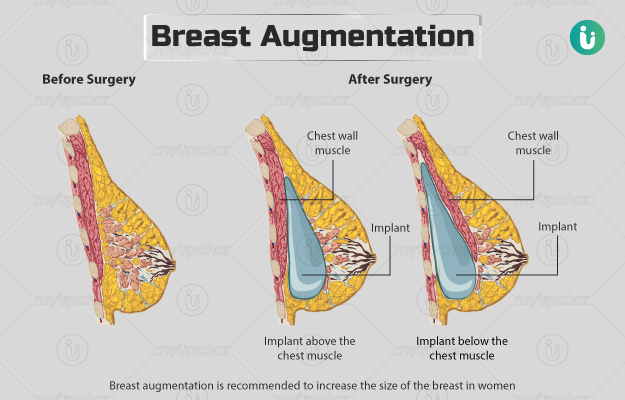Summary
Breast augmentation is recommended to increase the size of the breast in women who are not satisfied with the appearence of their breasts or those who have reduced breast volume due to a surgery for tumour or cyst removal. The procedure can be performed by making incisions at different locations on the breast area to place implants or fatty tissue. The surgery comes with general risks such as infection and haematoma. Breast implants are not permanent, and you may have to replace them in a few years. Hence, it is essential to regularly visit your doctor, get rergular breast exams, and be alert for signs of complications.
Breast augmentation may also be done in men to enhance or correct chest appearance.
- What is breast augmentation?
- Why is breast augmentation recommended?
- Who can and cannot get breast augmentation?
- What preparations are needed before breast augmentation?
- How is breast augmentation done?
- How to care for yourself after breast augmentation?
- What are the possible complications/risks of breast augmentation?
- When to follow up with your doctor after a breast augmentation surgery?
What is breast augmentation?
Breast augmentation, also called augmentation mammoplasty, is a surgical procedure that is done to increase the breast size. It may be performed by placing an implant in the breast or transferring fat from other parts of the body to the breast, which is known as fat transfer breast augmentation. The surgery helps to gain breast volume and correct the symmetry of the two breasts.
Why is breast augmentation recommended?
Breast augmentation is done for the following:
- To increase the size and fullness of breasts.
- To improve breast size after pregnancy, with ageing, or after weight loss.
- To correct naturally asymmetrical breasts.
- If your self-confidence is affected due to small breast size.
- If one or both the breasts have an elongated shape or are not fully developed.
- To regain the normal appearance of the breast after surgery for removal of a tumour or cyst.
- If you need re-augmentation or a change of prosthesis (implants)
Breast augmentation may also be done in men who wish to enhance their chest size, or have an absent chest muscle (pectoralis) on one side from birth, or have deformity in chest muscles.
Are you also troubled by obesity and are not able to lose weight even after a lot of efforts, then start using myUpchar Ayurveda Medarodh Weight Control Tablet today and control your weight.
Who can and cannot get breast augmentation?
Breast augmentation may not be advisable:
- In pregnant women.
- If a person has an active breast infection or cancer, as the surgery can interfere with these conditions.
- If a person is currently undergoing radiation treatment for cancer.
- In an individual who is sensitive to silicone, since the implant is usually made of that material.
- If a person has a previous history of an autoimmune disease (a condition in which the immune system attacks the body).
- To psychologically unstable people or those who have unrealistic expectations from the surgery.
Breast augmentation will not be able to correct sagging breasts. A breast lift along with this procedure is needed to make breasts look more youthful and fuller.
What preparations are needed before breast augmentation?
Before the surgery, your doctor will explain the entire procedure to you, and you can clarify any doubts that you may have.
Additionally, as a part of the pre-operative preparation, your doctor may ask you to:
- Get a blood test done.
- Modify your current medication regimen or add some medicines to it.
- Discontinue some medicines that increase bleeding such as aspirin.
- Discontinue habits such as smoking or taking recreational drugs.
Inform your surgeon before the surgery if you have:
- A weak immune system due to any medicines or any pre-existing disease.
- Medical conditions that delay healing or lower the supply of blood to the breast tissue.
- Diagnosis of mental health conditions such as depression. In this case, your doctor may advise you to wait until your situation has improved.
You will need to sign a consent form before the surgery.
You will need to arrange for someone to drive you home after the surgery.
How is breast augmentation done?
The exact surgical procedure depends on the type of implant used. There are various types of implants based on size, shape, texture, position of placement, etc. The implant surface may be smooth or textured, it may be filled with either saline or silicone gel, and would have a round or a teardrop shape.
Implants used for male breast augmentation are made of cohesive silicone gel or solid, pliable, silicone polymer. These implants are oval or rectangular in shape, can be reshaped by the surgeon with scissors and do not rupture.
Breast augmentation using an implant is performed in the following manner:
- You will be given local anaesthesia (which numbs the area, but you will be awake) or general anaesthesia (a sleep-inducing medicine) so that you do not feel pain from the procedure.
- The surgeon will make an incision (cut) in your breast area to insert the implant. The incision can be made in three different locations on the breast. It may be:
- Peri-areolar (around the nipple) incision
- Transaxillary (in the armpit to give access to the chest muscle) incision
- Inframammary (through the fold under breast, the most commonly used incision).
- The implant will be placed below your breast tissue or either under or above the pectoral (chest) muscle. This placement depends on the type of implant and the surgeon’s decision on which is best for you.
Breast augmentation with fat grafting is performed in the following manner:
- The surgeon will use liposuction technique to take fat from your body parts with more fatty tissue such as thighs, abdomen or flanks.
- He/she will make multiple small incisions on your breast and inject the harvested fat into your breasts through these incisions.
Male breast augmentation is done as follows:
- The surgeon will make a 4-6 cm incision in your armpit. He/she will place an instrument through this incision to make space behind your pectoralis muscle to receive the implant.
- The implant is then placed into position, and the wound is closed with sutures.
- A compressive dressing is applied on the chest.
The surgeon will close the skin over your incision using sutures.
Breast augmentation surgery takes about 45 to 90 minutes to complete. You can expect the following after the surgery:
- The medical staff will move you to the recovery room where you will be monitored for a while.
- Drains will be placed in your breasts to remove any collected blood or fluid from the breasts.
- You will have bandages to cover your wound and support your breasts.
- The medical team will give you some instructions for the after care.
- Your doctor may prescribe some medications for pain and antibiotics to prevent infection.
You will be able to go home in a few hours or after the effect of the anaesthesia wears off. The implants are not permanent, and you may need to replace or remove them in case of any complications. The incision lines may fade in some months to a few years.
How to care for yourself after breast augmentation?
You may need the following care at home:
- You may experience some pain for about five days after the surgery, whereas the swelling and soreness may last for a few weeks.
- Over time, you can wear a bra despite the bandages to support your breasts.
- You will be advised to keep the surgical site clean to prevent infection. However, the doctor may ask you to not take a shower for a few days. This is to protect the wound and promote healing.
- For the first few weeks after the surgery, you may be advised to avoid exercise and applying pressure on your breasts. However, once your stitches are removed, your surgeon may advise you to massage the wound with lotion or cream to prevent the skin from getting dry.
- As a part of long-term care, your doctor will guide you about undergoing mammograms (X-ray image of the breast), conducting self-examination of your breasts, and protecting your implants from damage. You must follow these instructions well.
After this surgery, most women have better self-esteem and improved body image. The procedure is likely to make you feel more attractive or feminine if you were previously not satisfied with your breasts.
When to see the doctor?
You must visit or call your doctor immediately if you experience any of the following:
- Discharge from your nipple
- Redness, rashes, pain, or any other signs of infection
- Dimpling of the skin around the implant
- Injury to your breast
- Breaking of the implant
- Change in the position of the implant
- A lump in the breast
What are the possible complications/risks of breast augmentation?
Breast augmentation surgery is associated with the following complications:
- Infection: You may develop an infection at any time after the surgery. This can manifest as pain, rashes, redness, fever, or fluid collection around your breast. Rarely, a very severe form of infection called toxic shock syndrome can occur.
- Haematoma: Haematoma occurs due to the collection of blood around the implant, giving a bruised appearance to the area. It may cause pain and swelling and can either occur after surgery or due to injury in the breast.
- Difference in the size of the two breasts
- Capsular contracture: Since the implant is a foreign material to the body, the immune system forms a fibrous capsule around it that may contract and cause hardening of the breast.
- Numbness in the breast
- Implant damage, say due to an accident
- Delayed wound healing
- Thinning and shrinking of the skin around the breasts
- Swelling and enlargement of lymph nodes
- Increased chances of anaplastic large cell lymphoma, a rare type of lymphoma and breast cancer.
- Leakage from implant
- Difficulty in carrying out a mammogram and checking for cancer.
Due to any of the above complications, there may be a need for reoperation.
When to follow up with your doctor after a breast augmentation surgery?
You will have a follow-up appointment with your doctor in a few weeks to get your stitches removed. Breast augmentation is not a one-time procedure. Your implants may likely have to be replaced in a few years. So, you should visit your surgeon at least once a year to evaluate if it's time to replace the implants.
Disclaimer: The above information is provided purely from an educational point of view and is in no way a substitute for medical advice by a qualified doctor.
Surgery Cost In Your City
References
- American Society of Plastic Surgeons [Internet]. Illinois. US; Breast Augmentation
- Ramachandran K. Breast augmentation. Indian J Plast Surg. 2008 Oct;41(Suppl):S41–S47. PMID: 20174542.
- Kuzmiak CM, Damitz L, Burke R, Hwang M. Male Pectoral Implants: Radiographic Appearance of Complications. J Radiol Case Rep. 2016;10(3):11-19. PMID: 27200162.
- Fardo D, Pensler JM. Breast, Augmentation. [Updated 2020 Jul 20]. In: StatPearls [Internet]. Treasure Island (FL): StatPearls Publishing; 2020 Jan
- US Food and Drug Administration [Internet]. Maryland. US; Patient Education Brochure: Augmentation
- West County Plastic Surgeons of Washington University [Internet]. Washington University in St. Louis. US; Is breast augmentation with my own fat safe?
- MedlinePlus Medical Encyclopedia [Internet]. US National Library of Medicine. Bethesda. Maryland. USA; Breast Augmentation Surgery
- Better health channel. Department of Health and Human Services [internet]. State government of Victoria. Australia; Breast Augmentation Surgery (breast implants)
- Michigan Medicine [internet]. University of Michigan. US; Breast Augmentation Implant & Procedure Types













